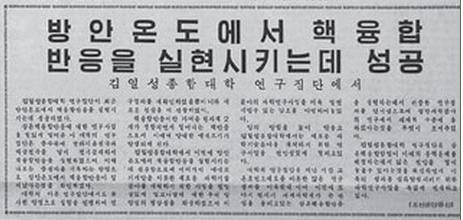 |
| 北은 반세기가 넘는 오랜 기간에 걸쳐 핵을 개발해왔다.1989년 5월8일자 <노동신문> |
[주] 아래 기사는 필자가 2014년 4월8일 작성한 글이다.
수년 전 소형 농축 우라늄 프로그램을 공개한 북한의 다음 수순은 ‘수소폭탄’ 보유가 될 가능성이 높다. 가까운 장래에 北이 공개할 가능성이 높은 비밀 무기로는 중성자탄, EMP(전자기 펄스), 소형 핵가방, 그리고 최종적으로는 ‘핵(核)잠수함 보유’가 될 것으로 여겨진다.
대다수의 국내외 언론들은 얼마 전까지만 해도 북한의 '핵융합 성공'(2010년 5월12일) 문제에 대해 가능성이 없다는 내용의 기사들을 쏟아냈다. 일례로 韓美 양국 정부는 북한의 핵융합 반응 성공 주장에 대해 “기술적으로 성공 가능성이 낮다”면서 회의적인 반응을 보였다.
북한의 우라늄 농축뿐 아니라 핵융합 기술에 대해서도 낮게 평가한 것이다. 2010년 8월 일본 언론에서 “북한이 핵융합 반응을 이용해 폭발력을 비약적으로 향상시킨 ‘핵폭탄 소형화’를 겨냥하고 있다”고 보도한 것에 대해서도 한국과 미국은 반응을 유보하는 태도를 보였다.
그러나 북한의 핵융합 기술에 대한 평가가 얼마 전부터 달라지고 있다. 일례로 김태영 前 국방장관은 2010년 국회 대정부질문에서 “북한이 핵융합 수소폭탄 제조를 위한 기초적인 수준의 연구도 충분히 시작했으리라 생각한다”며 노동신문 보도를 기정사실화했다.
상당한 수준에 도달한 북한의 핵기술 능력에 대해 일반 국민들을 속일 수는 있다. 그러나 북핵 문제를 오랜 동안 관찰해온 마니아들의 눈을 속일 수는 없다. 북한의 핵융합 성공 문제는 김정은 정권이 수소폭탄을 개발 중이라는 것을 만천하에 공개한 것에 지나지 않는다.
북한의 과학기술을 분석한 'XXXX정책연구원' 자료(非공개 자료)에 따르면 북한은 2008년 수립된 과학기술발전 5개년 계획의 20개 중점과제 중 원자력 분야 중점과제로 ‘핵융합분열 혼성원자로’를 선정, 연구를 시작했다고 밝히고 있다.
혼성원자로는 핵분열에 따라 사용된 연료를 핵융합으로 발생한 중성자를 이용해 재처리하는 원자로다. 자료는 북한의 혼성원자로 개발이 ‘강화형 핵폭탄’(우라늄-플루토늄 폭탄과 수소폭탄의 중간무기)과 수소폭탄 제조 능력을 확보하려는 의도라고 분석했다.
이와 함께 보고서는 “혼성원자로 같은 국방에 이용될 수 있는 분야는 관련 기관의 지원으로 비교적 풍부한 연구비를 사용한다. 대규모 인력과 설비, 연구비를 투입해 우수한 성과들이 도출되지만 비공개 원칙에 따라 학술지에 발표하는 논문은 거의 없다”고 밝혔다.
또 보고서는 “혼성원자로와 핵무기 등 국방에 응용되는 일부 특수 분야는 북한이 남한과 대등하거나 앞서 있다”고 평가했다. 북한의 원자력 분야 연구 인력은 영변 지역을 중심으로 핵심 인력 200여 명 등 3000∼5000명이 있다고 밝혔다.
미국의 경우 맨해튼 프로젝트에서 플루토늄 탄이 완성된 후 2년 만에 수소폭탄 개발에 성공했다. 당시 미국은 핵폭탄 개발 시 설계된 모형에 대한 계산을 현대와 같은 슈퍼컴퓨터로 하지 않았다. 수기식 계산으로 개략적인 계산을 통해 설계했으나 특이한 문제점은 없었다.
북한도 이미 80년대부터 자체 기술로 영변의 5메가와트 원자로를 설계-가동하고 있다. 그러므로 어떠한 모형의 핵물질에 대해서도 정확히 묘사-계산 가능한 핵계산 코드를 보유하고 있을 것으로 판단된다. 북한은 현재 핵개발에 필요한 기술상은 문제점은 없는 상태다.
대한민국이 정상적인 국가라면 북한의 핵능력을 숨길게 아니라 사실을 알리고, 미국의 한반도 핵 재배치 및 대응핵개발(자체 핵무장)을 논의하는 것이 정상일 것이다.
김필재(조갑제닷컴) spooner1@hanmail.net/

The Real Nuclear Threat
by Dan Eden for viewzone.com
In 2009, the following story escaped most news outlets but was widely reported on the Russian and European press:
KIEV, Ukraine -- Ukraine's security service says it has arrested a regional lawmaker and two companions for trying to sell radioactive plutonium for $10 million.
A ring of weapons-grade electrorefined plutonium-239 [right], with 99.96% purity. This 5.3 kg ring is enough plutonium for use in an efficient nuclear weapon.
The service says the legislator and two businessmen from the western Ternopyl region were detained last week in possession of a suspected 3.7 kilograms (8.2 pounds) of plutonium-239, which can be used to make a so-called dirty bomb. Such a bomb spreads radioactive material over a wide area.
The service said in a statement Tuesday it believes the material was produced in Russia during the Soviet era and smuggled into Ukraine through a neighboring country. Ukraine renounced nuclear weapons after the Soviet Union's collapse.
What you need to know about nuclear bombs
If you look in a physics book, you will be told that you need 10 kilograms (22 pounds) of weapon grade plutonium-239 to make a supercritical mass (nuclear explosion). For Uranium-235 it's even more -- about 33 pounds. But there's a lot of information about nuclear material that gets left out of the books. I hope to share some of this with you in this article even though I know it will scare you.
The truth is that by using something called a neutron reflector, the radiation coming from both plutonium and uranium can be sent back in to the radioactive material, greatly reducing the amount needed to form a critical mass by a little more than a half.
What's even more horrific to learn is that this small amount of fissionable material can either be used in a low yield 'atomic bomb' -- like the one's we dropped on Japan in WWII -- or they can be used as a detonator in a fusion hydrogen bomb.
Atom Bomb or H-Bomb... What's the difference?
An atomic bomb takes advantage of something called critical mass. This is the amount of radioactive material that, when brought together, will cause the material to suddenly explode.
Uranium and plutonium are unstable, or radioactive. This means that they are always shedding neutrons, a particle in their atomic nucleus, at a slow but steady pace. These neutrons usually fly off harmlessly into space at the speed of light but can be harmful if they strike a living organism. Their energy can burn cells and cause damage and mutations to DNA. When enough uranium or plutonium atoms are brought close together, their neutrons bump into other radioactive atoms and cause them to instantly shed more neutrons. So the pace of shedding neutrons can speed up.
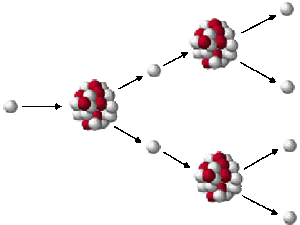 If a certain number of radioactive atoms are in close proximity to each other this shedding of neutrons can multiply exponentially. This is called a 'chain reaction.' Allowed to continue the radioactive material will explode. The amount of material needed to do this is known as the 'critical mass.'
If a certain number of radioactive atoms are in close proximity to each other this shedding of neutrons can multiply exponentially. This is called a 'chain reaction.' Allowed to continue the radioactive material will explode. The amount of material needed to do this is known as the 'critical mass.'
For natural weapons grade (99% pure) uranium this critical mass is about 33 pounds or a chunck the size of a soccer ball. Plutonium requires about 11 pounds to achieve critical mass.
The typical fission bomb is designed so that the critical mass of uranium is separated into several smaller pieces, then suddenly brought together for detonation. The principle is simple and effective.
The preferred technique forms the uranium or plutnium in the shape of a hollow sphere, so that the empty space in the center effectively separates the nuclear material and keeps it sub-critical. Explosive charges surround the sphere and, upon detonation, instantly implode and compress the material so that it reaches critical mass in the center of the sphere and explodes.
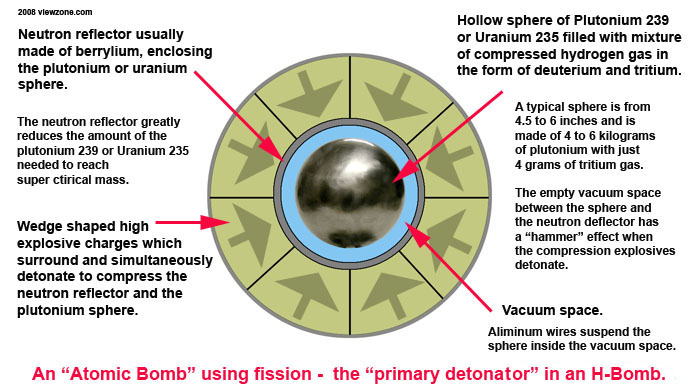
Scientists soon discovered that materials like Baryllium can reflect the neutrons, like a mirror reflects light. They found that if they enclosed the sphere of uranium or plutonium in a neutron reflective sphere upon detonation the amount of fissible material needed was significantly less. Neutrons that would usually fly off into space were directed back into the material, where they acted like additional mass.
After WWII, weapon production soon moved from Uranium to the lighter Plutonium, but the total weight needed for fission bombs dramatically limited their explosive size. The explosive effect is directly related to the amount of fissible material and even with the use of neutron reflectors the nuclear weapons were extremely heavy.
The H-Bomb
The next big improvement in nuclear bombs was the hydrogen bomb. Here the main source of the explosive reaction is not fission -- the breaking down of radioactive atoms and the release of energy -- but fusion, where atoms are forced together to form new elements with the release of even greater energy.
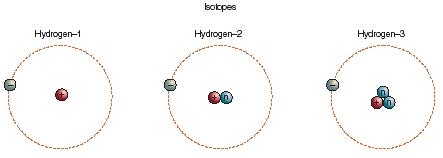
The main reaction in a hydrogen bomb is, of course, hydrogen. This is the lightest atom -- number 1 on the periodic table of elements. It has one electron orbiting its nucleus but the nucleus can exist with either one proton, a proton and a neutron, or a proton and two neutrons. The last two configurations are not usually found in nature and are the result of something either natural or artificial adding neutrons to the nucleus.
Hydrogen with a proton and neutron, call deuterium is created in the atmosphere from bombardment by cosmic radiation and is found in relative abundance in the ocean. Hydrogen with a proton and two neutrons in the nucleus is called tritium and is rarely found in nature. Tritium has a short life and degrades back to regular hydrogen in nature. To obtain a supply of tritium, scientists had to be very clever.
The exlosive power of a hydrogen bomb comes from the interaction -- fusion -- of a deuterium and tritium atom. The fusion reaction results in the formation of a Helium atom (number 2 on the periodic table) plus a free neutron and, here's the important part, the release of an amazing 17.6 MeV of energy!
Secrets Inside the H-Bomb
The nuclei of tritium and deuterium both have a positive charge and naturally repel eachother. Enormous pressure and energy must be used to compress them and allow the 'strong nuclear force' to take over. This is achieved by detonating a small fission atomic bomb in the confined space of the bomb casing and designing special reflecting surfaces to focus the intense x-rays and neutrons from this primary explosion to the secondary cylinder where the hydrogen will fuse.
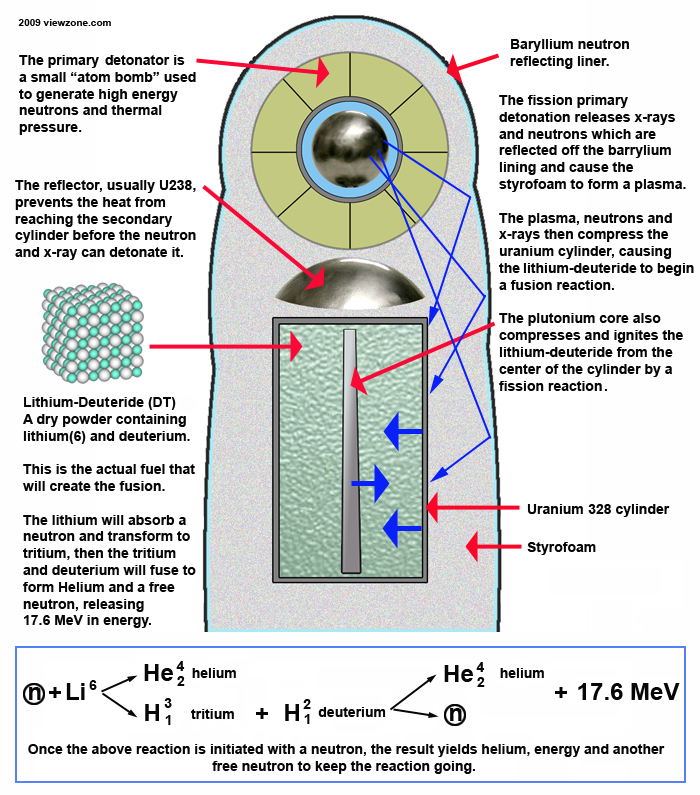
One of the main problems with the H-bomb was obtaining the tritium. Scientists found that they could generate this on-the-spot with a compound combining lithium (number 3 on the periodic table of elements) and deuterium, obtained from heavy water used to cool a reactor. The result was a dry, solid powder called Lithium-deuteride.
When a neutron (from the primary explosion) combines with a lithium atom, the result is a helium atom and a tritium atom. The tritium quickly finds and fuses with the deuteritium atom to fuse into a Helium atom and shoots a free neutron to start the reaction all over again. The fusion reaction causes the plutonium rod and the uranium cylinder case to contribute additional neutrons from fission and the resulting explosion is many magnitudes greater than an atomic bomb.
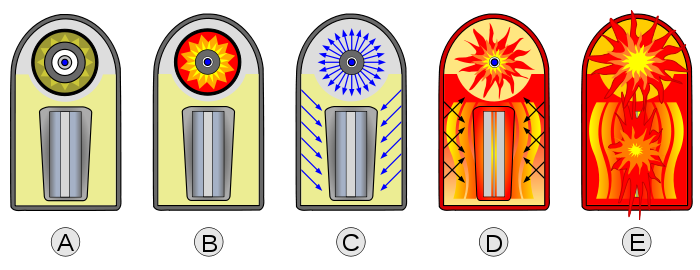
A:The stable bomb. B:The explosive charges surrounding the plutonium sphere detonate and compress against the barrylium reflector. C: The reflector compressed the plutonium sphere to critical mass where it ignites the tritium gas and causes a fission explosion. X-rays and heat cause the styrofoam to turn to plasma and reflect off the baryllium lined walls and focus on the secondary cylinder. D: The plasma and explosion compress the secondary cylinder causing the lithium-deuteride to react, releasing tritium and resulting in a fusion reaction. E: The uranium casing and plutonium rod contribute to the flux reaction and a fireball explodes.
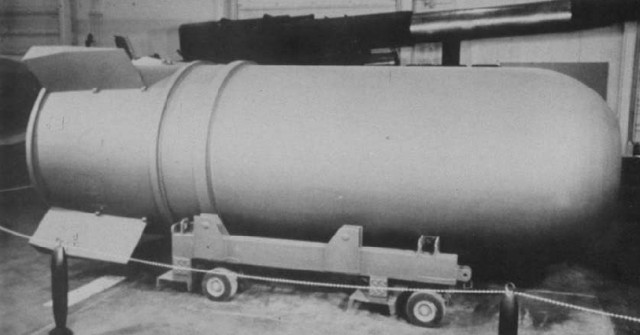
The worlds most powerful hydrogen bomb was detonated on the 30th of October 1961. The bomb had an explosive force of 58 megatons, or almost 6,000 times more powerful than the Hiroshima bomb. The bomb was dropped by an aircraft, and detonated 365 metres (1,200 feet) above the surface. The shock wave produced by this bomb was so powerful, it went thrice around the earth. The mushroom cloud extended almost 60 kilometres into the atmosphere. Resulting downfall was measured over the entire northern hemisphere. A flash of light could be observed all the way to Hopen in the Norwegian Sea, Sor-Varanger in the Norwegian county of Finnmark and by the Inari Lake in Finnish Lappland.
The REAL threat in 2010
| The main purpose of this article is to make you aware that a hydrogen bomb is just a very small, low yield atom bomb which has been combined with a non-radioactive compound that is readily available and plentiful. The compound is made from lithium -- the same element used in your laptop and cellphone batteries -- and hydrogen -- plentiful in the earth's oceans. Manufactured correctly, even a small amount of either plutonium or uranium is capable of detonating a hydrogen bomb which could vaporize everything for a 30 mile radius in less then a second.
So much of what we are told through tne media assumes that the radioactive material acquired by rogue nations or terrorists will be used in a fission bomb or a so-called 'dirty bomb'. The yields and limited areas of destruction are vastly out dated. While the public's understanding of nuclear technology has been frozen in the post WWII era, huge advances have been made under the veil of secrecy. Neutron reflectors and sophisicated detonation methods have increased the efficiency of even the most basic fission bomb while the discovery of lithium-deuteride has unfortunately made quantum leaps in the potential explosive destruction of fusion bombs. It's a new world -- a dangerous one. |
 North Korea is believed to have refined both enriched uranium and plutonium. In recent underground tests it is believed that an implosion fission bomb was successfully tested, although the world press immediately claimed it must have been a failure as the yield was not large, as suggested by monitoring the surrounding seismic readings.
North Korea is believed to have refined both enriched uranium and plutonium. In recent underground tests it is believed that an implosion fission bomb was successfully tested, although the world press immediately claimed it must have been a failure as the yield was not large, as suggested by monitoring the surrounding seismic readings.
In fact, underground tests often are used to test small implosion devices such as would be used for a primary detonator for a much larger H-bomb. The technology for the inert uranium-328 cylinder, filled with lithium-deuteride, is so simple that it needs no test. Simple electronic instruments can determine if the x-rays, neutrons and thermal pressure are adequate to activate a fusion reaction in a large scale H-bomb.
Hypothetically, North Korea could produce around 20 kilograms of 90 percent weapons grade uranium per year. Since Pyongyang already has developed implosion-type bombs, it could theoretically also produce an implosion-type design for an H-bomb, which would save considerable amounts of uranium. For example, if Pyongyang is already capable of building a compact, lower-yield atomic fission bomb (let's say the 4-kiloton bomb it told China it tested in 2006), it could easily use this as the primary stage of an H-bomb!
 Iran is already enriching uranium and may have accumulated enough uranium for a primary trigger already. The technology for converting this uranium to an H-bomb is dangerously simple. The media and politicians warn us of rogue nations being years away from making a bomb and speak of tens of kilotons of fissionable material needed for even a low yield or ''dirty' bomb, but the truth is much more terrible. This technology is easily within reach of any nation seeking to use its apocalyptic power. The physics is well understood and the amount of fissible material for the primary detonation is within reach. It is likely that several pounds of plutonium or uranium has already been secured and an H-bomb has been assembled.
Iran is already enriching uranium and may have accumulated enough uranium for a primary trigger already. The technology for converting this uranium to an H-bomb is dangerously simple. The media and politicians warn us of rogue nations being years away from making a bomb and speak of tens of kilotons of fissionable material needed for even a low yield or ''dirty' bomb, but the truth is much more terrible. This technology is easily within reach of any nation seeking to use its apocalyptic power. The physics is well understood and the amount of fissible material for the primary detonation is within reach. It is likely that several pounds of plutonium or uranium has already been secured and an H-bomb has been assembled.












 김필재
김필재








 트위터
트위터 페이스북
페이스북 네이버
네이버




























